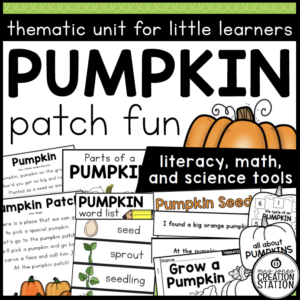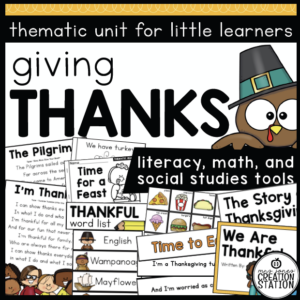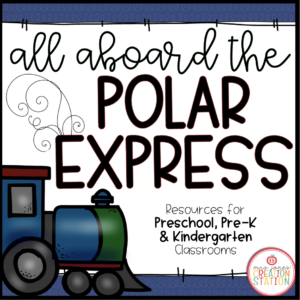OCEAN UNIT FOR PRESCHOOL, PRE-K AND KINDERGARTEN
In this pack, whole group, small groups and independent resources are used for thematic lessons about ocean life. Lesson plans with mini-lessons, center activities, and an interactive page are available for each week of instruction.
Buy the BUNDLE and SAVE! You can purchase this resources in the Thematic Activities for Little Learners Bundle and the Little Learners Mega-Bundle!
THIS RESOURCE INCLUDES
Lesson Resources
Week 34 Plans
This is a template for lesson plans during an ocean unit. Pick and choose what ideas and resources work for your learners.
Ocean – Whole Group
These resources can be used during whole group instruction for an ocean theme. They include a poem, word cards, tracing page and table sign in sheets.
Ocean Interactive Poem
Use this poem during a thematic lesson, whole group or a literacy center and have learners read about ocean animals they might meet.
Lesson Plans
Ocean Thematic Plans
Use these plans as a guide for engaging ocean read alouds and activities in the classroom.
At the Beach
Read At the Beach and have learners sort objects they need to take or activities they can do at the beach. Begin an ocean chart by drawing a beach.
Coral Reef
Reread Little Explorers: Under the Sea and have learners create animals that live in a coral reef using craft supplies. Add a coral reef to the ocean chart.
Open Ocean
Reread Little Explorers: Under the Sea and have learners create animals that live in the open ocean using craft supplies. Add the open ocean to the ocean chart.
Down Deep
Reread Little Explorers: Under the Sea and have learners create animals that live in the deep sea using craft supplies. Add the deep sea to the ocean chart.
Aquarium Trip
Read What Happens at an Aquarium? and have learners create a snorkeler craft and write about something they learned during the unit.
Scavenger Hunt
Have learners find coral reef animals around the room and write or trace them on their printable.
Ocean Sensory Charts
Explore the ocean with the five senses. Complete the charts together and have learners draw and write about their ocean experience using their senses on the interactive page.
Ocean Predictable Chart Class Book
Use this resource to create a class book from the predictable chart created during the week.
Literacy Centers
Literacy Center | CVC Words
Have learners match each picture to the correct CVC word.
Literacy Center | Initial Sound
Have learners clip the letter that is at the beginning of each picture on the clip cards..
Literacy Center | Sight Word WTR
Have learners find the sight words around the room and write them on their printable page.
Math Centers
Math Center | Graphing Data
Have learners sort and record the pictures on the chart. Two graphs are provided.
Math Center | Number Match
Have learners match the ways to form numbers zero through ten.
Math Center | Teen Counting
Have learners use the mats provided and count the correct number of starfish that crab saw.
LEARNING STANDARDS INCLUDED IN THIS RESOURCE
Common Core Standards
Language Arts
CCSSRF.K.1a
Follow words from left to right, top to bottom, and page by page.
CCSSRF.K.1c
Understand that words are separated by spaces in print.
CCSSRF.K.2d
Isolate and pronounce the initial, medial vowel, and final sounds (phonemes) in three-phoneme (consonant-vowel-consonant, or CVC) words. (This does not include CVCs ending with /l/, /r/, or /x/.)
CCSSRF.K.3a
Demonstrate basic knowledge of one-to-one letter-sound correspondences by producing the primary sound or many of the most frequent sounds for each consonant.
CCSSRF.K.3c
Read common high-frequency words by sight (e.g., the, of, to, you, she, my, is, are, do, does).
CCSSRI.K.1
With prompting and support, ask and answer questions about key details in a text.
CCSSRI.K.2
With prompting and support, identify the main topic and retell key details of a text.
CCSSRI.K.4
With prompting and support, ask and answer questions about unknown words in a text.
CCSSRI.K.7
With prompting and support, describe the relationship between illustrations and the text in which they appear (e.g., what person, place, thing, or idea in the text an illustration depicts).
CCSSRI.K.10
Actively engage in group reading activities with purpose and understanding.
CCSSSL.K.2
Confirm understanding of a text read aloud or information presented orally or through other media by asking and answering questions about key details and requesting clarification if something is not understood.
CCSSSL.K.5
Add drawings or other visual displays to descriptions as desired to provide additional detail.
CCSSW.K.2
Use a combination of drawing, dictating, and writing to compose informative/explanatory texts in which they name what they are writing about and supply some information about the topic.
Math
CCSSK.CC.A.2
Count forward beginning from a given number within the known sequence (instead of having to begin at 1).
CCSSK.CC.A.3
Write numbers from 0 to 20. Represent a number of objects with a written numeral 0-20 (with 0 representing a count of no objects).
CCSSK.CC.B.4
Understand the relationship between numbers and quantities; connect counting to cardinality.
CCSSK.CC.B.4a
When counting objects, say the number names in the standard order, pairing each object with one and only one number name and each number name with one and only one object.
CCSSK.MD.B.3
Classify objects into given categories; count the numbers of objects in each category and sort the categories by count.
CCSSK.OA.A.1
Represent addition and subtraction with objects, fingers, mental images, drawings, sounds (e.g., claps), acting out situations, verbal explanations, expressions, or equations.
Next Generation Science Standards
NGSSK-ESS3-1
Use a model to represent the relationship between the needs of different plants or animals (including humans) and the places they live. Examples of relationships could include that deer eat buds and leaves, therefore, they usually live in forested areas; and, grasses need sunlight so they often grow in meadows. Plants, animals, and their surroundings make up a system.
NGSSK-ESS2-2
Construct an argument supported by evidence for how plants and animals (including humans) can change the environment to meet their needs. Examples of plants and animals changing their environment could include a squirrel digs in the ground to hide its food and tree roots can break concrete.
Texas Essential of Knowledge and Skills
Language Arts
TEKSLA.K.2.A.iii
Developing and sustaining foundational language skills: listening, speaking, reading, writing, and thinking–beginning reading and writing… The student is expected to: demonstrate phonological awareness by: identifying the individual words in a spoken sentence.
TEKSLA.K.2.B.i
Developing and sustaining foundational language skills: listening, speaking, reading, writing, and thinking–beginning reading and writing…The student is expected to: demonstrate and apply phonetic knowledge by: identifying and matching the common sounds that letters represent.
TEKSLA.K.2.B.ii
Developing and sustaining foundational language skills: listening, speaking, reading, writing, and thinking–beginning reading and writing….The student is expected to: demonstrate and apply phonetic knowledge by: using letter-sound relationships to decode, including VC, CVC, CCVC, and CVCC words.
TEKSLA.K.2.B.iv
Developing and sustaining foundational language skills: listening, speaking, reading, writing, and thinking–beginning reading and writing…The student is expected to: demonstrate and apply phonetic knowledge by: identifying and reading at least 25 high-frequency words from a research-based list.
TEKSLA.K.2.C.i
Developing and sustaining foundational language skills: listening, speaking, reading, writing, and thinking–beginning reading and writing…The student is expected to: demonstrate and apply spelling knowledge by: spelling words with VC, CVC, and CCVC.
TEKSLA.K.2.C.iii
Developing and sustaining foundational language skills: listening, speaking, reading, writing, and thinking–beginning reading and writing…The student is expected to: demonstrate and apply spelling knowledge by: spelling high-frequency words from a research-based list.
TEKSLA.K.2.D.ii
Developing and sustaining foundational language skills: listening, speaking, reading, writing, and thinking–beginning reading and writing…The student is expected to: demonstrate print awareness by: holding a book right side up, turning pages correctly, and knowing that reading moves from top to bottom and left to right with return sweep.
TEKSLA.K.2.D.iii
Developing and sustaining foundational language skills: listening, speaking, reading, writing, and thinking–beginning reading and writing…The student is expected to: demonstrate print awareness by: recognizing that sentences are comprised of words separated by spaces and recognizing word boundaries.
TEKSLA.K.3.B
Developing and sustaining foundational language skills: listening, speaking, reading, writing, and thinking–vocabulary. The student uses newly acquired vocabulary expressively. The student is expected to: use illustrations and texts the student is able to read or hear to learn or clarify word meanings.
TEKSLA.K.5.B
Comprehension skills: listening, speaking, reading, writing, and thinking using multiple texts. The student uses metacognitive skills to both develop and deepen comprehension of increasingly complex texts. The student is expected to: generate questions about text before, during, and after reading to deepen understanding and gain information with adult assistance.
TEKSLA.K.5.D
Comprehension skills: listening, speaking, reading, writing, and thinking using multiple texts. The student uses metacognitive skills to both develop and deepen comprehension of increasingly complex texts. The student is expected to: create mental images to deepen understanding with adult assistance.
TEKSLA.K.5.H
Comprehension skills: listening, speaking, reading, writing, and thinking using multiple texts. The student uses metacognitive skills to both develop and deepen comprehension of increasingly complex texts. The student is expected to: synthesize information to create new understanding with adult assistance.
TEKSLA.K.5.I
Comprehension skills: listening, speaking, reading, writing, and thinking using multiple texts…The student is expected to: monitor comprehension and make adjustments such as re-reading, using background knowledge, checking for visual cues, and asking questions when understanding breaks down with adult assistance.
TEKSLA.K.6.B
Response skills: listening, speaking, reading, writing, and thinking using multiple texts. The student responds to an increasingly challenging variety of sources that are read, heard, or viewed. The student is expected to: provide an oral, pictorial, or written response to a text.
Math
TEKSMA.K.2.A
Number and operations. The student applies mathematical process standards to understand how to represent and compare whole numbers, the relative position and magnitude of whole numbers, and relationships within the numeration system. The student is expected to: count forward and backward to at least 20 with and without objects.
TEKSMA.K.2.B
Number and operations. The student applies mathematical process standards to understand how to represent and compare whole numbers, the relative position and magnitude of whole numbers, and relationships within the numeration system. The student is expected to: read, write, and represent whole numbers from 0 to at least 20 with and without objects or pictures.
TEKSMA.K.2.C
Number and operations. The student applies mathematical process standards to understand how to represent and compare whole numbers, the relative position and magnitude of whole numbers, and relationships within the numeration system. The student is expected to: count a set of objects up to at least 20 and demonstrate that the last number said tells the number of objects in the set regardless of their arrangement or order;
TEKSMA.K.2.D
Number and operations. The student applies mathematical process standards to understand how to represent and compare whole numbers, the relative position and magnitude of whole numbers, and relationships within the numeration system. The student is expected to: recognize instantly the quantity of a small group of objects in organized and random arrangements;
TEKSMA.K.8.A
Data analysis. The student applies mathematical process standards to collect and organize data to make it useful for interpreting information. The student is expected to: collect, sort, and organize data into two or three categories;
TEKSMA.K.8.B
Data analysis. The student applies mathematical process standards to collect and organize data to make it useful for interpreting information. The student is expected to: use data to create real-object and picture graphs
TEKSMA.K.8.C
Data analysis. The student applies mathematical process standards to collect and organize data to make it useful for interpreting information. The student is expected to: draw conclusions from real-object and picture graphs.
Science
TEKSSCI.K.7.B
Earth and space. The student knows that the natural world includes earth materials. The student is expected to: observe and describe physical properties of natural sources of water, including color and clarity; and
TEKSSCI.K.9.A
Organisms and environments. The student knows that plants and animals have basic needs and depend on the living and nonliving things around them for survival. The student is expected to: differentiate between living and nonliving things based upon whether they have basic needs and produce offspring
TEKSSCI.K.9.B
Organisms and environments. The student knows that plants and animals have basic needs and depend on the living and nonliving things around them for survival. The student is expected to: examine evidence that living organisms have basic needs such as food, water, and shelter for animals and air, water, nutrients, sunlight, and space for plants
CONNECT WITH MJCS
WEBSITE | FACEBOOK | INSTAGRAM | PINTEREST | TEACHERS PAY TEACHERS
© Mrs. Jones’ Creation Station, Inc




